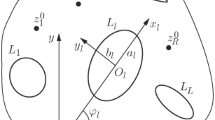Abstract
This paper describes a method for determining the strain state of a thin anisotropic plate with elastic arbitrarily arranged elliptical inclusions. Complex potentials are used to reduce the problem to determining functions of generalized complex variables, which, in turn, comes down to an overdetermined system of linear algebraic equations, solved by singular expansions. This paper presents the results of numerical calculations that helped establish the influence of rigidity of elastic inclusions, distances between inclusions, and their geometric characteristics on the bending moments occurring in the plate. It is found that the specific properties of distribution of moments near the apexes of linear elastic inclusions, characterized by moment intensity coefficients, occur only in the case of sufficiently rigid and elastic inclusions.
Similar content being viewed by others
References
S. G. Lekhnitskii, “Some Issues Associated with the Bending Theory of Thin Plates,” Prikl. Mat. Mekh. 2 (2), 181–209 (1938).
S. G. Lekhnitskii, Anisotropic Plates (Gostekhteoretizdat, Moscow, 1957; Gordon and Breach, New York, 1968).
V. B. Meglinskii, “Some Problems of Bending of Thin Multiply Connected Anisotropic Plates,” in Some Problems of the Elasticity Theory of Stress and Strain Concentration of Elastic Bodies, No. 3, 97–127 (1967).
A. S. Kosmodamianskii, Stress State of Anisotropic Media with Holes or Cavities (Vishcha Shkola, Kiev–Donetsk, 1976) [in Russian].
S. A. Kaloerov, “Complex Potentials of Bending Theory of Multiply Connected Anisotropic Plates,” Teor. Prikl. Mekh., No. 4, 115–136 (2012).
S. A. Kaloerov and E. S. Goryanskaya, “Two-Dimensional Stress–Strain State of Multiply Connected Anisotropic Body,” in Mechanics of Composites, Vol. 7: Stress Concentration (A. S. K., Kiev, 1998) [in Russian].
S. A. Kaloerov and D. A. Dobryak, “Theroelastic State of a Piecewise Anisotropic Plate,” Visn. Donetsk. Univ., Ser. A. Prirod. Nauki 2, 77–88 (2006).
S. A. Hwu and J. Yen Wen, “On the Anisotropic Elastic Inclusions in Plane Elastostatics,” J. Appl. Mech. 60, 626–632 (1993).
C. Hwu, Anisotropic Elastic Plates (Springer, New York, 2010).
S. A. Kaloerov, E. V. Avdyushina, and A. B. Mironenko, Stress Concentration in Multiply Connected Isotropic Plates (Izd. Donetsk. Nats. Univ, 2013) [in Russian].
M. C. Hsieh and C. Hwu, “Anisotropic Elastic Plates with Holes/Cracks/Inclusions Subjected to Out-of-Plane Bending Moments,” Int. J. Solids Struct., 39 (19), 4905–4925 (2002).
D. V. Grilitskii, V. K. Opanasovich, and L. O. Tisovskii, “Elastic State of a Plate with a Round Plug and Rectilinear Thin Elastic Inclusion,” Prikl. Mat. Mekh. 46 (6), 993–1000 (1982).
N. G. Stashchuk, Problems of Mechanics of Elastic Bodies with Crack-Like Defects (Naukova Dumka, Kiev, 1993) [in Russian].
G. E. Forsythe, M. A. Malcolm, and C. B. Moler, “Computer Methods for Mathematical Computations,” in Prentice-Hall Series in Automatic Computation (Prentice-Hall, Englewood Cliffs, New Jersey, 1977).
S. A. Kaloerov, “Determination of Stress Intensity, Induction, and Intensity Coefficients for Multiply Connected Electroelastic Anisotropic Media,” Prikl. Mekh. 43 (6), 56–62 (2007).
Author information
Authors and Affiliations
Corresponding author
Additional information
Original Russian Text © S.A. Kaloerov, A.A. Koshkin.
Rights and permissions
About this article
Cite this article
Kaloerov, S.A., Koshkin, A.A. Solving the Problem of Bending of Multiply Connected Plates with Elastic Inclusions. J Appl Mech Tech Phy 58, 1123–1129 (2017). https://doi.org/10.1134/S0021894417060190
Received:
Revised:
Published:
Issue Date:
DOI: https://doi.org/10.1134/S0021894417060190



